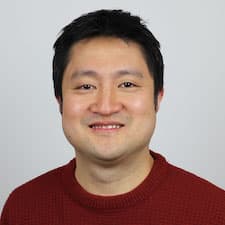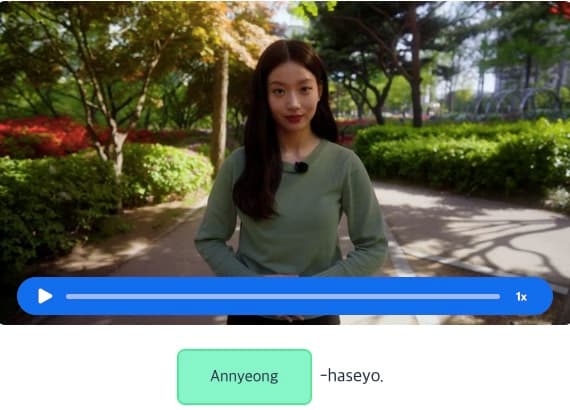I want to learn...
Author:

Keehwan Kim
Learning how to say hello is usually the first phrase you’ll learn when learning a language. And it’s also one of the most important phrases to master since you’ll hear it and use it all the time.
However, many languages have different ways to say hello – depending on who you’re speaking to, or the situation you’re in – and Korean is no different. Korean is a hierarchical language, so you always need to use the proper formality level to avoid offence for being too casual or too formal. In this guide, we’ll cover how to say hello in Korean formal and informal settings, how to say hello in Korean on the phone, and some other useful greetings all Korean students should learn. We do use the Korean alphabet Hangul in this article, so check out Korean for beginners to learn more about the Korean alphabet.
Hello in Korean
The most casual form ofhello in Koreanis 안녕 [An-nyeong] and we generally use it only with close friends and close family members, such as our siblings. The adjective form is 안녕하다 and it means to be in good health and comfort, and we can use this adjective to say hello with varying degrees of formality.
How to write hello in Korean in varying degrees of formality
| Formality | Korean | Romanization |
|---|---|---|
| Formal | 안녕하십니까 | [An-nyeong-ha-sim-ni-kka] |
| Polite | 안녕하세요 | [An-nyeong-ha-se-yo] |
| Casual | 안녕 | [An-nyeong] |
Hello in Korean formal
안녕하십니까 [An-nyeong-ha-sim-ni-kka]
The most formal way to say hello in Korean is 안녕하십니까 [An-nyeong-ha-sim-ni-kka] and we mainly use this in very formal settings and when we are speaking to people in very high level of seniority. This means that 안녕하십니까 is not commonly used in everyday life.
In general, young children will rarely (if at all) use 안녕하십니까, and even teenagers and people in their early 20’s rarely use this form of hello, even when they are in formal settings.
As well as only being used in very formal settings, 안녕하십니까 is more commonly used by the older generation.
Hello in Korean polite
안녕하세요 [An-nyeong-ha-se-yo]
The most common form of hello in Korean is 안녕하세요 [An-nyeong-ha-se-yo] and although it is not a formal hello, it is still a polite and respectful way of saying hello. We can use this phrase in almost every situation, from greeting someone’s mother, to a server in a restaurant.
Hello in Korean informal
안녕 [An-nyeong]
As mentioned earlier, the casual form of hello in Korean is 안녕 [An-nyeong] and this is mainly used between close friends and family members. The other important point to note is that 안녕 is more commonly used between young people, and adults will use it when greeting young children.
Tip:안녕 can be used as both ‘hello’ and ‘goodbye’, but the formal and polite versions of hello can’t be used to say goodbye.
More Korean greetings
Another use of 안녕하다
We can change nearly all verbs and adjectives into their honorific forms by adding (으)시다, so the honorific form of 안녕하다 is 안녕하시다, and sometimes we can use the past and polite form as a greeting that’s more that just hello. For example:
안녕하셨어요? [An-nyeong-ha-syeo-seo-yo?] - This loosely translates to ‘Have you been well?’
This form of greeting is mainly used when we greet those in a more senior position.
Good morning in Korean
To say ‘good morning’, we can use the following phrase.
‘Good morning’ in varying degrees of formality in Korean
| Formality | Korean | Romanization |
|---|---|---|
| Formal | 좋은 아침입니다. | [Jo-eun a-chim-im-ni-da.] |
| Polite | 좋은 아침이에요. | [Jo-eun a-chim-i-e-yo.] |
| Casual | 좋은 아침. | [Jo-eun a-chim.] |
Korean greetings - Have you been well?
A very common greeting in Korean is to ask ‘have you been well?’. We sometimes say ‘hello’ and then ask this question, and at other times, we just ask this question.
‘Have you been well?’ in varying degrees of formality in Korean
| Formality | Korean | Romanization |
|---|---|---|
| Formal | 잘 지냈습니까? | [Jal ji-nae-seum-ni-kka?] |
| Polite | 잘 지냈어요? | [Jal ji-nae-sseo-yo?] |
| Casual | 잘 지냈어? | [Jal ji-nae-sseo?] |
잘 means well, and the verb in these phrases is 지내다 which means ‘to spend time’. So we use its past form, 지냈다 to ask whether the other person has spent their time well.
Naturally, because of the meaning of this question, we would only use these phrases with those we already know. We don’t use these phrases with people we’ve only just met.
Generally speaking, the formal form is rarely used, and when we want to be more formal and respectful, we use the honorific form 지내시다 to ask the same question in a more polite manner.
Using 지내시다
| Formality | Korean | Romanization |
|---|---|---|
| Formal | 잘 지내셨습니까? | [Jal ji-nae-syeo-seum-ni-kka?] |
| Polite | 잘 지내셨어요? | [Jal ji-nae-syeo-sseo-yo?] |
Because these phrases use 지내시다 rather than 지내다, they are more respectful than the phrases that use 지내다. We don’t use 지내시다 to casually ask how someone has been. Also, of the two phrases that use 지내시다, the polite form is more commonly used in everyday life.
As ‘Have you been well?’ is a question phrase, it’s important to respond with an answer.
A: 잘 지내셨어요? (Have you been well?)
B: 네, 잘 지냈어요. (Yes, I’ve been well.)
Although the person asking the question can use the verb 지내시다 to be more respectful, we don’t use 지내시다 to say ‘I’ve been well’. To say ‘I’ve been well’, we have to use 지내다.
Korean greetings - How have you been?
To ask how someone has been, we change 잘 with 어떻게, and 어떻게 means ‘how’.
‘How have you been?’ in varying degrees of formality in Korean
| Formality | Korean | Romanization |
|---|---|---|
| Formal | 어떻게 지냈습니까? | [Eo-tteo-ke ji-nae-seum-ni-kka?] |
| Polite | 어떻게 지냈어요? | [Eo-tteo-ke ji-nae-sseo-yo?] |
| Casual | 어떻게 지냈어? | [Eo-tteo-ke ji-nae-sseo?] |
To be more formal and respectful, we can also use 지내시다 rather than 지내다.
Using 지내시다
| Formality | Korean | Romanization |
|---|---|---|
| Formal | 어떻게 지내셨습니까? | [Eo-tteo-ke ji-nae-syeo-seum-ni-kka?] |
| Polite | 어떻게 지내셨어요? | [Eo-tteo-ke ji-nae-syeo-sseo-yo?] |
Similar to ‘have you been well’, the use of the polite form is more common in everyday life.
Korean greetings - Long time no see
To say ‘long time no see’, we use the word 오랜만. It is the shortened form of 오래간만, and it refers to a long time between two activities. So if you played tennis for the first time in 10 years, and you want to say that you are playing tennis for the first time in ages, you can use 오래간만 or 오랜만.
Similarly, when you haven’t seen someone in ages, and you want to say long time no see, then you can use 오래간만 or 오랜만. In general, the use of 오랜만 is more common, but in more formal settings, the use of 오래간만 is also common.
‘Long time no see’ in varying degrees of formality in Korean
| Formality | Korean | Romanization |
|---|---|---|
| Formal | 오래간만입니다. | [O-rae-gan-man-im-ni-da.] |
| 오랜만입니다. | [O-raen-man-im-ni-da.] | |
| Polite | 오랜만이에요. | [O-raen-man-i-e-yo.] |
| Casual | 오랜만이야. | [O-raen-man-i-ya.] |
When we use these phrases, we can use adverbs like 너무 (very) and 정말 (really) to further emphasize how long it has been since our last meeting.
너무 오랜만이에요. (It’s been so long.)
정남 오랜만이에요. (It’s been really long.)
How to say hello in Korean on the phone
To say ‘hello’ when we answer the phone, we use a different word altogether.
여보세요. [Yeo-bo-se-yo.]
여보세요 is only used when answering the phone, and we don’t use this phrase in any other situation.
Other common greetings in Korean
I’m home
다녀왔습니다. [Da-nyeo-wa-seum-ni-da.] - I’m home.
This phrase is often used by children or teenagers when they come back from school. This phrase uses 다녀오다 which basically means to go and come back, so when we come back from school, we say this phrase to let our parents know that we are back home.
Adults can also use a similar phrase, but they would use the polite form of this sentence. So when one of the parents comes home from work, they may say 다녀왔어요, or 갔다왔어요 or 왔어요 which are less formal but still polite phrases.
Have you eaten?
식사하셨어요? [Sik-sa-ha-syeo-sseo-yo?] - Have you eaten?
When Korean people meet around mealtime, one of the first questions we ask each other is ‘have you eaten?’. Asking this question is polite and considerate, so it’s a very common question to ask as a form of greeting. We don’t ask this question instead of saying hello, but we may use this question with other greeting phrases and say something like ‘안녕하세요? 식사하셨어요?’ or ‘오랜만이에요. 식사하셨어요?’.
The less formal, but still polite version of the phrase is ‘밥먹었어요?’.
Mastering how to say hello in Korean
Remember, while most common way to say hello is ‘안녕하세요’, this is the polite way of saying hello in Korean. However, the phrase can change depending on the situation and the people we are speaking to. So if you want to brush up on some more Korean greetings, why not head over to the Busuu app and start practicing greetings today!
AUTHOR

Keehwan Kim
Newlanguages


